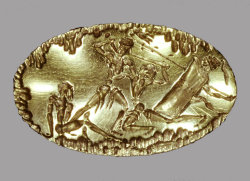Seals & sealings - About
A seal is a small portable artefact mostly made of stone but also found in other materials, such as bone/ivory, metal, and various artificial pastes. It displays engraved motifs and is equipped with a means which allows it to be worn on the body.
The first stamps in the Aegean are encountered in the early Neolithic period. These were, however, probably not meant for impressing on clay but must have had a different function than the Bronze Age seals (stamping dye on skin? stamping bread?). The first seals proper in the Aegean are encountered in EB II. Seals continue to be made down to the end of the Bronze Age.


Two examples of Aegean seals: To the left, gold signet ring from Mycenae (CMS I no. 16); to the right, steatite three-sided prism (CMS III no. 232 a)
Seals would have played an important role in Aegean society and, as functional objects, they would have served three main purposes: securing, marking, and authorizing. These functions are attested through the different types of carriers of ancient seal impressions. When securing an object, seals would have been impressed on clay lumps placed on an object, such as a container or a door, in such a way that it could not be opened without the destruction of the clay lump and the impression(s) on it. In their use for marking, seals were impressed on clay lumps hanging with a string from an object or even directly on an object, such as a pot. In these cases, the seal impression must have provided information which was somehow related to the object, such as its contents, its provenance, its creator, or its owner. When used as proof of authorization seals were impressed on free standing lumps of clay which were perhaps used as tokens, i.e. providing authorization for certain dealings, services or commodities, or even as receipts.
Sealing with impressions of twelve different seals and that of a rolled/folded piece of leather tied with a string on its backside: left: front and back side; right: drawing of front side showing the positioning of the different impressions. (Chania Museum 1559)
Another secondary or in some periods perhaps also primary function of the seals would have been that of personal adornment. In this function, the seals could have variously possessed an amuletic character, have been insignia of status, or even have had a purely decorative character.
More than 10.000 examples of Aegean seals and their ancient impressions have been preserved. Owing to their miniature images, they are the most important source for Aegean iconography. Moreover, the study of their materials, techniques and iconography as well as their use for sealing provides important insight into the Aegean sociopolitical organization and administration.




